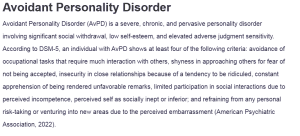Avoidant Personality Disorder
Avoidant Personality Disorder (AvPD) is a severe, chronic, and pervasive personality disorder involving significant social withdrawal, low self-esteem, and elevated adverse judgment sensitivity. According to DSM-5, an individual with AvPD shows at least four of the following criteria: avoidance of occupational tasks that require much interaction with others, shyness in approaching others for fear of not being accepted, insecurity in close relationships because of a tendency to be ridiculed, constant apprehension of being rendered unfavorable remarks, limited participation in social interactions due to perceived incompetence, perceived self as socially inept or inferior; and refraining from any personal risk-taking or venturing into new areas due to the perceived embarrassment (American Psychiatric Association, 2022).
These features are typically coupled with prominent impairment in social and occupational functioning. Unlike social anxiety disorder, AvPD is more of a lifelong pattern than situational. That is the difference because AvPD is so severe that it often leads to years of isolation, missed opportunities, and other disorders like major depression or generalized anxiety disorder.
Media Representation of Avoidant Personality Disorder
The complexities of Avoidant Personality Disorder are often depicted in fictional narratives, and through this, the disorder’s strong effects on individuals can be delineated. One of the strongest examples is Charlie Kelmeckis, the protagonist of The Perks of Being a Wallflower. To a large extent, Charlie’s behaviour patterns meet the DSM-5 criteria for AvPD. He suffers from great social inhibition; he does not like being in social situations unless coerced or encouraged from the outside.
His aversion to criticism and rejection manifests as perpetual self-doubt, which prevents him from establishing any good relationship. For example, Charlie often isolates himself in situations where he feels emotionally challenged by the possibility of being judged or ridiculed by others. His introversion and over-analysis of every interaction with others are manifestations of the self-view of being socially awkward or inferior, typical for AvPD (Utami, 2019).
Moreover, his reluctance to participate in new experiences brings out the fear of embarrassment and failure. Through Charlie’s struggles, The Perks of Being a Wallflower gives a bright picture of how AvPD controls behaviour and relationships—raising understanding among its audiences.
Treatment Options for Avoidant Personality Disorder
Avoidant Personality Disorder, though difficult to treat, shows good response rates to combined treatment interventions of psychotherapy and pharmacological interventions. Cognitive-behavioral therapy (CBT) is, to date, the most effective, whereby maladaptive thought patterns are identified and altered. Using exposure techniques and cognitive restructuring, the individual with AvPD begins to learn how to face fears of rejection, gradually building confidence in social interactions—according to Fariba and Sapra (2023).
Another important part of CBT is teaching patients how to relearn negative feedback and reduce self-criticism to address their oversensitivity to evaluation (Nakao et al., 2021). Since anxiety and depression sometimes co-occur with AvPD, doctors may prescribe medications, especially selective serotonin reuptake inhibitors (SSRIs), to help treat these conditions. Group therapy also provides a warm milieu to allow for the practice of social skills and to give individuals a sense of belonging.
Notably, the therapeutic relationship is particularly important: a consistent and empathetic therapeutic relationship creates an ambiance of trust and encourages long-term engagement. Early intervention—especially in adolescence or early adulthood—can significantly improve the prognosis and enable individuals to lead more fulfilling lives.
In conclusion, feelings of inadequacy, hypersensitivity to criticism, and ingrained social inhibition are the hallmarks of the complicated and frequently misinterpreted avoidant personality disorder. Media portrayals, such as that of Charlie Kelmeckis in The Perks of Being a Wallflower, provide insight into the problems of the individual with AvPD and shed light on its emotional and social influence. Evidence-based treatments—CBT, pharmacotherapy, and group therapy—all offer effective pathways toward recovery and give the individual a chance to surmount his fears and develop better relationships. Understanding and addressing AvPD enhances not only individual outcomes but also promotes a more compassionate societal perspective on mental health disorders.
References
American Psychiatric Association. (2022). Diagnostic and Statistical Manual of Mental Disorders (DSM-5-TR). Psychiatry.org; American Psychiatric Association. https://www.psychiatry.org/psychiatrists/practice/dsm
Fariba, K. A., & Sapra, A. (2023). Avoidant Personality Disorder. PubMed; StatPearls Publishing. https://pubmed.ncbi.nlm.nih.gov/32644751/
Nakao, M., Shirotsuki, K., & Sugaya, N. (2021). Cognitive–behavioral Therapy for Management of Mental Health and stress-related disorders: Recent Advances in Techniques and Technologies. BioPsychoSocial Medicine, 15(1), 1–4. https://doi.org/10.1186/s13030-021-00219-w
Utami, P. N. (2019). Personality Disorder Of Charlie Kelmeckis In The Perks Of Being A Wallflower (2012) Film. Repository.uinjkt.ac.id, 23(2). https://repository.uinjkt.ac.id/dspace/handle/123456789/45832
ORDER A PLAGIARISM-FREE PAPER HERE
We’ll write everything from scratch
Question
Details
Avoidant personality disorder
You will find a character with this personality disorder from a movie, book, TV show, or other form of media that is available to view/read. You will then write a paper in APA format, between 2-3 pages, not including the title page or reference page.
Requirements:
The first section you will discuss Avoidant personality disorder and define the main characteristics and DSM criteria.
In the second section your group will choose a character with this personality disorder from a movie, TV show, book or any form of media that is available for viewing. Identify the ways in which this character meets DSM criteria for this personality disorder.
The final section will focus on the recommended treatment options for this personality disorder.

Avoidant Personality Disorder
Criteria
Personality Disorder: Full and complete description of Avoidant personality disorder including main characteristics and DSM criteria.
Character: All criteria included
Treatment: All criteria included.
References
Grammar
APA
Resource:
- DSM-5-TR text
- American Psychiatric Association. (2013). Diagnostic and statistical manual of mental disorders (5th ed.)

